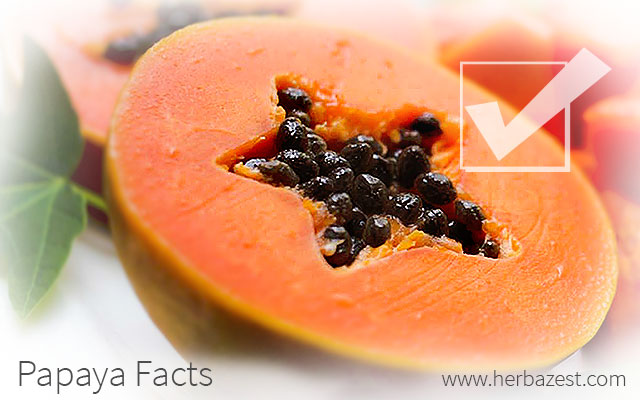These interesting facts about papaya may help to explain why this tropical delicacy has long been heralded as the fruit of angels:
The Latin name for papaya is Carica papaya. This tall, herbaceous tree-like plant can reach up 6 - 30 feet (2 - 9 m), and it is a member of the Caricaceae botanical family.
The papaya tree is thought to be native to the tropical regions of southern Mexico and Central America.
With black, ovoid seeds encapsulated in a thin, gelatinous membrane, botanically speaking, papaya is a fruit. However, it is sometimes roasted or prepared in salads as a vegetable.
Australians and New Zealanders call papaya 'paw paw', which has been the source of widespread confusion, since American English recognizes paw paw as the custard apple, the fruit of the Asimina triloba plant.
Although commonly referred to as a tree, papaya plants have no woody tissue or branches. Their fruits grow directly from the thick, leaf-scarred stem.
The term 'papaya' was introduced by Spaniards and Portuguese travelers in the 16th century, and it is a misspelled form of the Taíno word ababaia.
India is the largest producer of papayas, generating over three million tons of the fruit annually. Other major producers include Mexico, Brazil, Nigeria, China, and the Philippines.
Papaya fruits can grow as heavy as 20 lbs (9.1 kg) or more.
Papaya's fruit shape is determined by the sex of the plant. Female flowers produce round fruits, while pear-shaped and oblong fruits come from hermaphroditic flowers.
The unripe, green papaya contains a high amount of latex. Unripe papayas are used to tenderize tough meats several hours prior to cooking.
Papaya seeds are spicy and pepper-like. They can be dried, ground, and used to impart flavor to salad dressings, casseroles, and other foods.
Papayas contain the digestive enzyme papain, which is used as a detox, mild laxative and treatment for indigestion and other bowel problems.
Papayas have been used in traditional folk medicine to prevent unwanted pregnancy, expel worms, clear skin problems, and treat sexually-transmitted illnesses.
While the flesh of a ripe papaya shows a variation of yellow, pink, orange, or red hue, green papayas are virtually white on the inside.
The papaya leaf, although bitter, is often boiled and cooked like a spinach or kale.
With the highest content of natural sugars, the red papaya is the sweetest.
The great value of papaya nutrition lies in its high amount of vitamin C (ascorbic acid), providing as much as 75% of the daily recommended intake per 150 gram serving.
Papayas contain only 43 calories per 100 gram serving. Most of these come from complex carbs.
Papaya possess an antioxidant action that reduces cholesterol, blocks free radical damage, and promotes cellular regeneration. It is also effective in lowering glucose levels and high blood pressure.
Grown in the state of West Bengal, India, the world's largest papaya plant was 44 feet (13.4 m) tall.
Papaya facts are fun and interesting, but the best way to learn more about the history and importance of the papaya fruit is to delve into the current research and scientific studies surrounding its use.
Sources
- Fairchild Tropical Botanic Garden, Classifying fruit
- Genetics and Genomics of Papaya, p. 8
- Guinness World Records, 2017, p. 89
- International Tropical Fruits Network, Papaya – Common varieties
- Journal of Food Composition and Analysis, Ascorbic acid, vitamin A, and mineral composition of banana (Musa sp.) and papaya (Carica papaya) cultivars grown in Hawaii, 2006
- Missouri Botanical Garden, Asimina triloba
- National Horticulture Board, Papaya
- National Institutes of Health, Vitamin C
- Papaya & Bengal Quince
- Papaya the Medicine Tree, pp. 16 – 17
- Purdue University, Carica papaya L. | Papaya, Carica papaya L.
- Stanford University, Bananas are berries?
- Talking Taino, pp. 77 – 78
- University of Wyoming, Nutrition and Food Safety, Papaya power!
- USDA Agricultural Research Center, Vitamin and mineral content of tropical fruit cultivars grown in Hawaii
- USDA Nutrient Database, Papayas, raw




